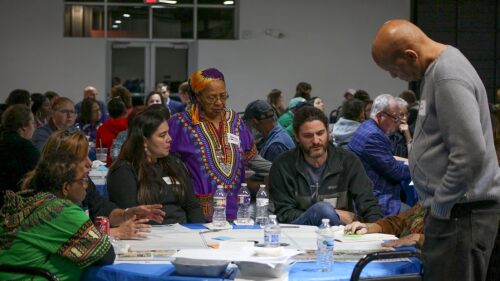The ULI Health Leaders Network is empowering real estate and land use professionals with the skills, knowledge, and networks to improve health outcomes in their professional practice and communities. The 32 health leaders who were selected for Cohort 1, which ran from October 2017 to June 2018, undertook a series of activities, including in-person gatherings, learning-focused webinars with leaders in the health and built-environment fields, small group work, and individual assignments.
Using the right language and understanding community needs, as they relate to health and opportunities to be healthier, are critical for both built-environment and health professionals when working across professional disciplines to create healthy and livable places and projects. Health leaders interviewed friends or family members—outside of the traditional health or built-environment professions—on whether (and how) they think about how the built environment affects their health, their biggest influences on their own health, and where they typically get health-related information.
Through these conversations, health leaders gleaned ways to better communicate with a broader audience about how their communities have an impact on their health and uncovered important lessons for communicating with those outside of your own discipline.
- Take time to make sure you are speaking a common language and eliminate the jargon:
Diane Caslow, vice president of strategic and business planning at MedStar Health in Columbia, Maryland, said, “[My friend] did not immediately connect the meaning of the built environment and health together, but with further conversation, what is meant is just ‘part of where you live.’ This is an important connection to use common language when translating from the professional’s view of the built-environment elements to connect with how people are thinking about how their surroundings, and how things were and are being built, impact people’s health.”
Jane Winslow, associate professor in the Department of Landscape Architecture and Urban Planning at Texas A&M University in College Station, Texas, found that “the use of health jargon such as ‘built environment’ seemed to be confusing. When discussed as ‘activities’ and ‘habits,’ or ‘placemaking characteristics,’ concepts seemed to be more effectively communicated. I was somewhat surprised that my son did not mention that he walks two blocks from home to work, as he participates in physical activity on a daily basis. If I could summarize in one sentence: To more effectively communicate, health leaders need to rely on terms understood by multiple audiences, and not use jargon that confuses people.”
- Do not make assumptions about what people know and do not know:
“Remove your experience and education from the picture and meet others where they are at in their understanding,” writes Katherine Hebert, healthy community design specialist at Centralina Council of Governments in Charlotte, North Carolina. “What makes common sense to you and what you have been talking about for years is not necessarily easy for others to understand, and don’t get frustrated when they don’t. Your experience with the built environment may be totally different if you grew up in a healthy community and they have not. So be as specific and relatable as you can and accepting of the other’s perspective and check your bias at the door. For example, it is easier to say that having a playground in the neighborhood helps kids play, be physically active, and healthy to a mom than to say something about the availability of quality education leading to better job preparedness, which leads to better pay, health insurance, empowerment, and greater access to health-promoting resources. Start with things that are most important to the audience and easier to grasp and let that open the door for more intricate conversations.”
- When talking about impacts of community design on health, make connections to daily life that people will understand and make it personal:
Dominic Ruiz, senior analyst in business development at Delos in New York, New York:
“After interviewing [my partner], I realized that there is still a large knowledge gap that we have to bridge as real estate and land use professionals. For [my partner], health and the built environment were understood more as a reactive measure that is taken when something goes wrong in a building or in a community such as emergency services. I think that this perception may be very common across the general population but believe that there are many ways that we can show and express that the built environment can actually promote better health in a proactive way.
I think drawing connections between things that people know and use most frequently is a good way to express this. For example, asking a question related to proximity to food and how far you have to go to get it and then asking how it would affect their life if they had to go ten times further to get that same food.”
Bill Mahar, senior associate at Norris Design, Denver, Colorado:
“Make it personal. Speak to people’s hearts. If the public can understand that the design of the
built environment can impact their personal well‐being and health, they are better positioned to
support the development of parks, sidewalks, schools in walkable locations, etc. Find out what they value about their community and is it tied to the health of the community? Start messaging in local schools. Encourage programs in schools that speak to the importance of creating a community that supports health. Include the importance of health with all city building efforts. This will ensure that various components of health are being discussed with future planning and city development.”
Tim McCarthy, managing principal at Hart Howerton, New York, New York:
“One thing that could be communicated better, even in [the general media such as] People Magazine, would be ‘incremental change’—90 percent of our lives are routine. Little things like drinking water through the day or getting up to walk to a colleague’s desk and talk, is all beneficial—both physically [fitness to move around] and mentally [engaging socially with a friend]. Use smartphone apps to make those types of reminders after someone reads about it from a celebrity; or, banner ads sponsored by [organizations like the] Robert Wood Johnson Foundation on health benefits that drive an expanded curiosity in the population as a whole.”
- Understand the audience when crafting a message or talking points about health:
“Be sure to match the source of information/messenger and the message to the intended audience,” Hebert also writes. “For example, an older adult may be more likely to trust his or her doctor whom he or she sees regularly about health-related topics. While a younger individual who rarely sees a doctor and is constantly connected to a smartphone, tablet, or TV might receive the bulk of his or her health information from the internet and commercials. Someone of a different race/ethnicity or from a lower income level may not be getting the information at all or might be turning to other service providers or community leaders for their health information. It just depends on the person, the situation, and the information you’re trying to get across. And it may take persistence and multiple attempts or creative approaches to get the message across.”
- Consider talking about “quality of life” over “health,” if that resonates more:
From her interview, Julia Katz, healthy communities planner at Katz Planning and Upstream Works Collaborative in Durham, North Carolina, concluded that “in general, building healthy communities means building communities that are easy to live in. Life is better when you live near things that you need and want, particularly when they can be easily accessed without a car. Instead of talking about health outcomes as the reason for designing healthy communities and buildings, quality of life may be a more compelling reason that everyone can relate to.”





